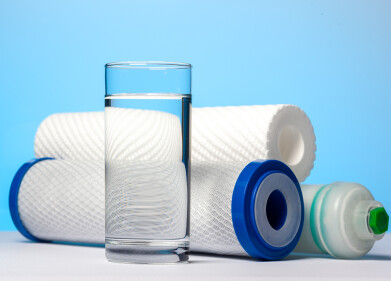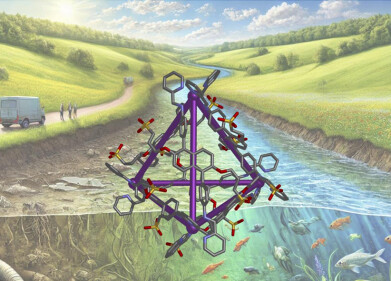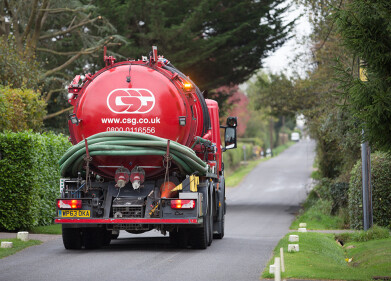Wastewater treatment
Foam Under Control in Wastewater Treatment Works
Apr 27 2009
Occasionally in life a problem occurs for which there appears to be no solution. This was the case on a Wastewater Treatment Works, with recurrent problems of high levels of FOGs in the influent. Not only did it cause build-up and blockage in pump chambers, but it also generated very high levels of filamentous foam. This was to such an extent that spillage onto site footpaths and roadways was causing a serious hazard and regular cleanup work was required, often daily. In addition the works experienced poor final effluent quality as a result of the build-up
of a layer of filamentous scum on the surface of the final clarifiers.
In June 2007, site management began investigating the use of a Foam Skimmer, an innovative system introduced to the UK by the environmental solutions provider, Corgin. After confirmation of site details and the identification of a suitable point from which to remove the foam, a system proposal and quotation was submitted. Based on the history of success elsewhere, and as the problem showed no sign of disappearing, an order was placed for a Foam Skimmer FS1020B to be installed in the outlet channel from the aeration tanks.
The Foam Skimmer was installed in early February 2008, and successfully commissioned. The scum is now continuously removed by the Foam Skimmer at 3-6% solids, and pumped to waste sludge tanks. It is important not to return it to the headworks so that the removed filamentous bacteria cannot re-seed the aeration tank. Over a short period of time, the site operator noticed a definite effect on the final clarifiers, with the disappearance of the scum layer and a resultant reduction of final suspended solids. Added to this benefit was the end of any spillage
over onto the footpath and roadway, giving welcome relief from the maintenance work required, and as importantly, the removal of a serious hazard. With continuing effective operation, the Foam Skimmer has made itself indispensable to site staff. They are very happy with its performance, commenting: “It does what it says on the tin!” Available in both bracket-mounted and float-mounted designs, the Foam Skimmer is a unique, innovative machine which selectively removes foam as well as foam-causing filaments (e.g. Microthrix and nocardioforms) from mixed
liquors. The continuous removal of filamentous bacteria, their concentrated food source and their preferred environment, can effect many positive changes to the operation of plants. These include:
• Better settlement – reduction of waste sludge volumes and associated disposal/treatment costs
• Reduced suspended solids in final effluent – increased compliance
• Improved aeration efficiency – giving all round plant performance improvements
• Improved nitrification from the reduction of filaments, improved sludge age and the increase in aeration effectiveness
As well as the impacts on plant biology and running costs, there are many other practical benefits to be experienced by removing foam, which can create an unsightly, hazardous mess and hamper equipment operation, especially tertiary treatment and dewatering.
Foaming problems on activated sludge plants are well known. A common cause in domestic wastewater treatment is the presence of excessive foam-causing filaments such as Microthrix parvicella and “nocardioforms”. These filaments are relatively easy to recognise, but their cause is often more elusive. Very often they are associated with high FOGs (fats, oils and greases), in the influent stream, a lack of inadequate primary treatment, septicity and / or biological nutrient removal (BNR) processes. Once foam-causing filaments become established, they can be difficult to eradicate. The foam that they create is stable and provides an ideal environment and a readily available food source, including FOGs, dead cell material and septic conditions. In addition, the foam continually reseeds the plant, giving these filaments a further selective advantage. Foam trapping – to prevent high suspended solids (SS) carryover in the final effluent – exacerbates these problems.
To break this vicious cycle, the foam clearly needs to be removed. Various methods have been tried over the years with varying degrees of success, including chlorination or the use of other oxidising agents especially in the form of surface sprays; the dosing of Aluminium salts; and the use of selectors and scum traps of various designs. These methods vary in their level of effectiveness, and very often good results are synonymous with high costs and or a high level of operator input. For these reasons, effective foam control in problematic plants using these
methods is seldom sustained.
By contrast, the Foam Skimmer provides a highly effective solution for foam removal and has been in use on the Continent for well over 10 years. This innovative system can remove up to 80m³ or more foam per day and thicken it to 3-6% dry solids, doing so continuously and at very low operating cost. Such is its ingenuity and effectiveness, that it was awarded the coveted Ernst-Kuntz prize in 1998.
Events
Mar 18 2025 Expo Santa Fe, Mexico
Mar 18 2025 Moscow, Russia
Mar 19 2025 Manila, Philippines
Mar 20 2025 Guangzhou, China
Mar 24 2025 National Harbour, MD, USA














